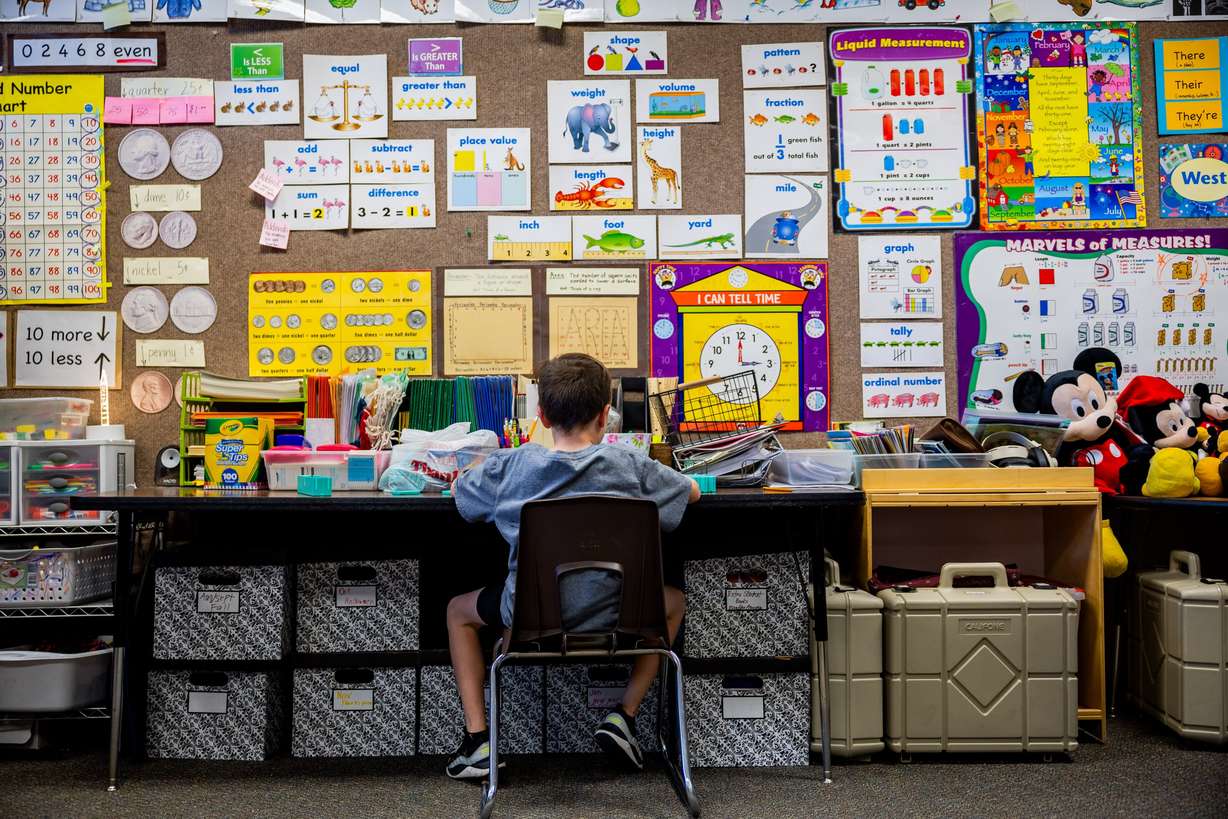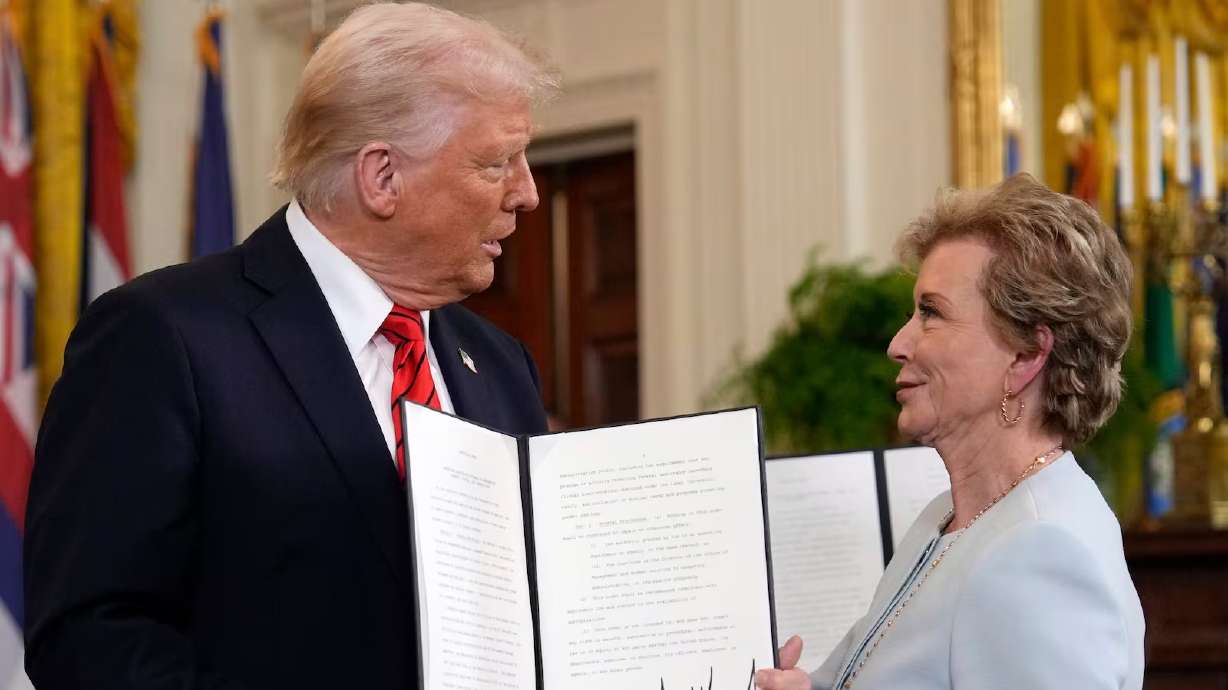Estimated read time: 5-6 minutes
- President Donald Trump's budget proposes a $12 billion cut to the Education Department.
- Title I funding for low-income students remains at $18.4 billion.
- The budget consolidates several programs, increasing state flexibility and reducing federal control.
SALT LAKE CITY — Last March, President Donald Trump signed an executive order seeking the elimination of the Education Department — calling the 46-year-old federal agency "a big con job" and pledging to move all things education "back to the states where it belongs."
Trump added that many of the Education's Department's "useful functions" — including Title I funding and resources for children with disabilities — "will be fully preserved" and "redistributed to various other agencies and departments."
Now the Trump administration is articulating its specific Department of Education fiscal intentions in its recently released annual White House budget proposal — which will ultimately require Congressional approval.
The department's 2026 budget request advances Trump's plan to "reach balance and restore confidence in America's fiscal management by eliminating spending that does not support meaningful learning and returning responsibility for services that are better provided by the states, local governments, or civil society organizations to each respectively."
Added the document: "Our goal is clear: to make education better, fairer, and more accountable by ending federal overreach and empowering families, schools, and states who best know the needs of their students."
The Education Department is requesting $66.7 billion — an approximate $12 billion reduction (or about 15%) from the 2025 appropriation.
The proposed budget cut, according to the document, "reflects an agency that is responsibly winding down."
Proposed allocations for Title I, programs for students with disabilities
As Trump promised, the Education Department's budget request asserts it maintains the current Title I allocations of $18.4 billion.
Title I funds aim to help students from low-income families achieve in the classroom.
"The request recognizes the importance of funds under Title I-A Grants to Local Educational Agencies (LEAs), which serve as a critical source of support for LEAs in communities of concentrated poverty," the document noted.
"This program also provides considerable flexibility to LEAs on how to use the funds to best address the needs of their students — which is consistent with the Administration's goal to return education back to the states while maintaining support for families and their students."
More than 108,000 Utah K-12 students benefit from Title I money.

The Education Department also administers the Individuals with Disabilities Education Act that helps schools pay for services for students with disabilities.
The agency's 2026 budget request provides $14.9 billion for the Individuals with Disabilities Education Act Grants to States program — about $677 million more than the 2024 appropriation. It also calls for consolidating the Preschool Grant program and the Special Education National Activities programs into the Grants to States program.
The Grants to States program, the request noted, will continue to be allocated to states and Local Educational Agencies. States will receive additional flexibility to reserve funds for state-level activities — including those currently supported under the National Activities programs.
States, the proposal added, would continue to meet key Individuals with Disabilities Education Act accountability and reporting requirements "aimed at ensuring a free appropriate public education is available to all students with disabilities" while protecting the "rights of those students and their families."
The document said the proposals reflect the Trump administration's commitment to increasing flexibility for states "while limiting federal overreach into schools."
The National School Lunch Program, which reimburses Utah schools and other states for students receiving free or reduced school meals, is administered by the U.S. Department of Agriculture — not the Education Department.

The department's 2026 budget proposal argues that federal support for education in the past has supported programs ill-suited for states.
As a result, the budget proposal added, "states are forced to hire increasingly large numbers of staff not to serve students, but to apply for competitive grants and manage the bureaucratic red tape imposed by the federal government. … It is time for the federal government to get out of the way of states and localities as they turn their attention to education outcomes instead of compliance with Federal red tape."
What's being chopped/consolidated in the Education Department's budget proposal?
While calling for maintained support for flexible Title I grants to Local Educational Agencies, the Education Department's 2026 budget includes a proposed "K-12 Simplified Funding Program," which would consolidate many currently federally funded grant programs for elementary and secondary education into a single "state formula" grant program.
"States and localities would have flexibility to use (Simplified Funding Program) funds for any number of elementary and secondary education activities, consistent with the needs of their communities," the document states.
The budget request notes it would maintain separate funding for Impact Aid and Indian Education — "both in support of underserved student populations."
But the Trump administration is not requesting funding for several stand-alone elementary and secondary education programs for 2026.
"These eliminations are part of the Administration's overall effort to restore fiscal discipline and reduce the federal role in education. States and localities, not the federal government, are best suited to determine whether to support the activities authorized under the various programs within their own budgets and without unnecessary administrative burden imposed by the federal government."
Existing Education Department-funded programs being eliminated as stand-alone programs — and instead being recommended for consolidation into the K-12 Simplified Funding Program — include programs promoting literacy; enhanced library programs; education services for "Neglected, Delinquent & At-Risk Children;" the McKinney-Vento programs assisting homeless students; rural education programs; and arts education for students, including those with disabilities.
The Education Department budget proposal does not include requests for future funding for the Supporting Effective Educator Development program.
Also eliminated from the budget proposal are funds for migrant education.









